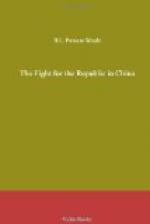Dr. Goodnow’s method is simplicity itself. In order to prove the superiority of Monarchism over Republicanism—and thus deliberately ignoring the moral of the present cataclysmic war—he ransacks the dust-laden centuries. The English Commonwealth, which disappeared nearly three hundred years ago, is brought forward as an example of the dangers which beset a republic, though it is difficult to see what relation an experiment made before the idea of representative government had been even understood bears to our times. But there is worse. The statement is deliberately made that the reason for the disappearance of that Commonwealth was “that the problem of succession after the death of Cromwell was difficult to solve.” English historians would no doubt have numerous remarks to offer on this strange untruth which dismisses a remarkably interesting chapter of history in the most misleading way, and which tells Chinese political students nothing about the complete failure which military government—not republicanism—must always have among the Anglo-Saxon peoples and which is the sole reason why Cromwellism disappeared. Even when treating the history of his own country Dr. Goodnow seems to take pleasure in being absurd. For he says: “The mind of the American people was so imbued with the idea of republicanism that a republican form of government was the ideal of the whole race”; then adding as if to refute his own statements, “Had General Washington—the leader of the revolutionary army—had the desire to become a monarch he would probably have been successful.” We do not know how Americans will like this kind of interpretation of their history; but at least they will not fail to note what dismal results it hastened on in China. With the experimental Eighteenth Century French Republic; with the old Spanish Colonies of Central and South America; and above all with Mexico, Dr. Goodnow deals in the same vein. Vast movements, which can be handled only tentatively even in exhaustive essays are dismissed in misleading sentences framed so as to serve as mere introduction to the inevitable climax—the Chinese Constitutional Monarchy of 1915 with Yuan Shih-kai as Emperor.
Yet this is not all. As if in alarm at the very conclusions he so purposely reaches, at the end of his Memorandum he reduces these conclusions to naught by stating that three impossible conditions are necessary to consummate the Restoration of the Monarchy in China, (1) no opposition should be aroused, (2) the law of succession must be properly settled, (3) Full provision must be made for the development of Constitutional Government. That these conditions were known to be impossible, everyone in the Far East had long admitted. Had Dr. Goodnow paid the slightest attention to the course of history in China he would have known (a) that any usurpation of the Throne would infallibly lead to rebellion in China and intervention on the part of Japan, (b) that Yuan Shih-kai’s power




